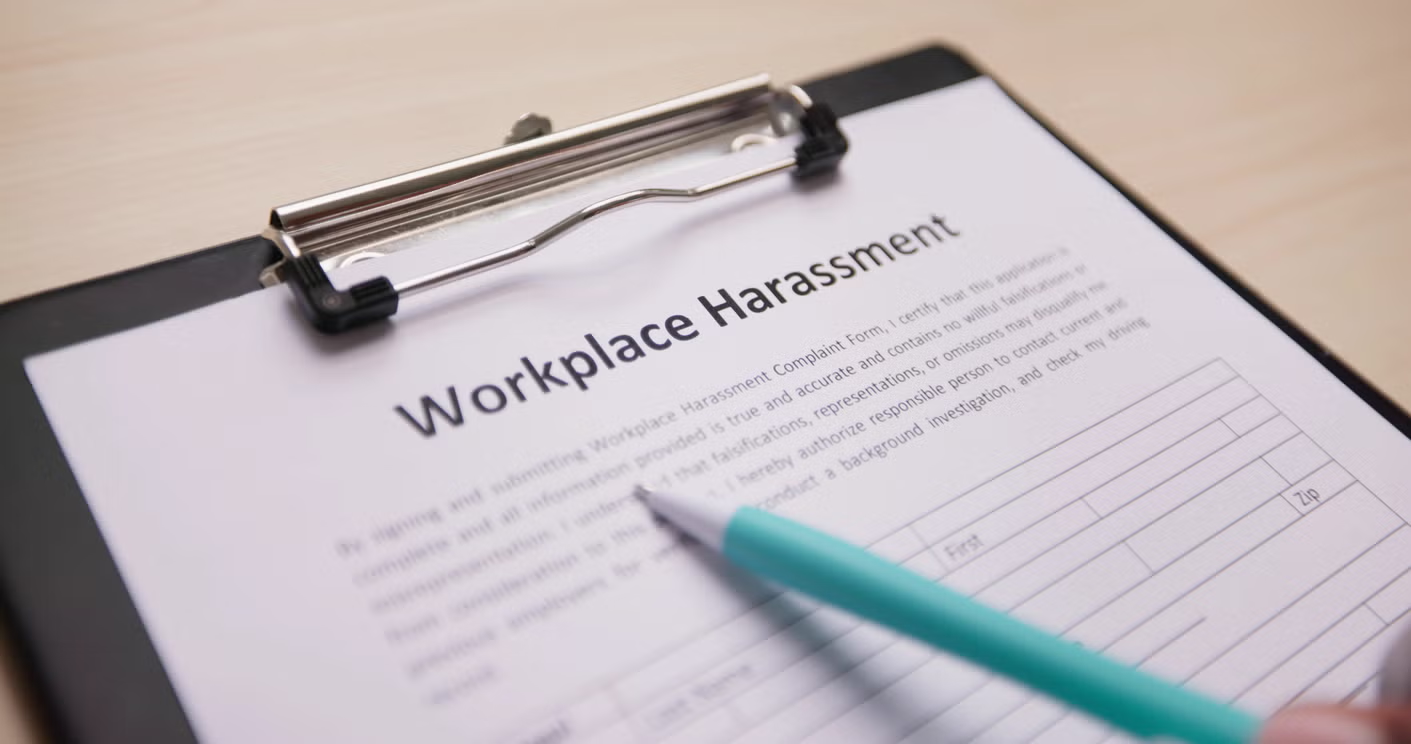Your support helps us to tell the story
Support NowOur mission is to deliver unbiased, fact-based reporting that holds power to account and exposes the truth.
Whether $5 or $50, every contribution counts.
Support us to deliver journalism without an agenda.

Louise Thomas
Editor
It started when he squeezed her thigh in a meeting. “I was young, inexperienced, and didn’t want to cause a fuss, so I pretended it hadn’t happened,” recalls Zoe* of the incident involving her manager at the time. Things escalated quickly. “He started to walk past me in the office and stroke my face. It happened once during a team meeting and I snapped at him; he made a joke out of it and said I ‘wasn’t even attractive’ in front of everyone.” After reporting her manager’s behaviour to the director of the company, Zoe was moved to a different job. “I was basically demoted,” she says.
That’s not the end of the story: Zoe moved to another corporate firm that she soon learnt had a reputation for misconduct. “The CFO was in a photobooth at a work party with two younger women and grabbed their breasts,” she says. “There was literally photographic evidence of it but, after I complained to HR, I was simply told to delete it.” Then she was targeted herself during an interview with a male colleague: “He got his penis out and asked me to touch it. I left the room and reported it immediately but was told it was my word against his. Whenever I’ve complained about things like this, it has been insinuated that I was encouraging the behaviour or just ‘causing problems’.”
Stories like this were supposed to be a thing of the past. Zoe’s experiences happened in 2019, two years after the #MeToo movement shone a light on the alarming prevalence of sexual harassment in the workplace. Powerful predators who’d been protected for decades were being exposed and held to account. Women were speaking up without fear of retribution and bravely sharing their allegations. After millennia of being shrouded in secrecy, the systemic prevalence of sexual harassment across the world was finally being dealt with in the cold light of day.
But here we are in 2024, a year in which allegations are being made at such a relentless pace that it serves only to highlight just how much further we have to go if we’re to ever invoke any meaningful change. Currently, all eyes are on Mohamed al-Fayed, the late Harrods owner and subject of a watershed BBC documentary in which five former employees claim to have been raped by the billionaire. Since airing, the documentary has paved the way for more than 200 women to come forward with more allegations against Fayed, who died in 2023. Many are believed to have been assaulted or harassed during their time under his employment.
Frankly, the most astonishing thing about the Fayed allegations is that they are a mere drop in the ocean when you consider the litany of other recent #MeToo stories. Last November, there was the McDonald’s scandal: the fast food chain’s UK boss admitted it was receiving between one and two sexual harassment claims a week. In March this year, it was revealed that the CBI had used gagging clauses to prevent its own staff from discussing experiences of sexual misconduct, according to a Guardian investigation. And just this week, a former Meta staffer who was placed on a “do not hire” list after stalking and sexually harassing a male colleague was rehired by the company.
None of this is helped by the fact that, in April, the New York State Court of Appeals overturned Harvey Weinstein’s 2020 rape conviction – the one that resulted from the landmark #MeToo case that spawned and galvanised the entire movement back in 2017. It’s almost impossible not to ask the question nobody wants to ask: did #MeToo really change anything at all?
Almost two-thirds of women have been sexually harassed at work, according to a 2023 poll by the Trades Union Congress. Meanwhile, a more recent survey involving more than 1,000 women working at organisations with 250+ employees, conducted by INvolve, a diversity and inclusivity consultancy firm, found that more than half (55 per cent) of women believe the women in their workplace are at risk of sexual harassment, while one in four said they’d witnessed sexual harassment in their workplace in the last five years.
Perhaps more concerningly, though, is the lack of faith in how these incidents are dealt with by employers: less than half (48 per cent) of those surveyed think their employer has developed a clear sexual harassment policy, and nearly one in five (17 per cent) of women said their workplace had not taken any actions to reduce the likelihood of sexual harassment.

“From my perspective, the level of workplace sexual harassment has remained largely unchanged since the #MeToo movement,” says Sarah Gilzean, partner and accredited specialist in discrimination law at Morton Fraser MacRoberts. “While the movement has undoubtedly raised awareness and encouraged more people to come forward, I haven’t observed any significant reduction in the overall frequency of such cases.”
Zoe agrees: “ I would love to say that things have changed for women in the workplace, but they absolutely haven’t. Misogyny and harassment still run rife; men are just more careful about how they do it, and who they do it in front of.”
One of the key issues is that when harassment does occur, it often goes unreported, with the TUC finding that fewer than one in three women (30 per cent) who experienced sexual harassment at work had told their employer. When you hear stories from those who have reported it, it’s not hard to understand the reticence.
“At a work Christmas party in 2017, one of the directors of the company came up to me and said I looked like I should be in a porn film in my outfit, referring to my tight leather trousers,” says Lauren*. “I felt so uncomfortable I left the party, and called my boyfriend at the time, crying.” The next day, the director sent Lauren an email. “It said, ‘I fancy the f*** out of you.’ This was particularly disgusting as he is married with two children and I used to work with his wife.”
Lauren reported the incident, and the director was swiftly investigated by HR. “But during the investigation, he was allowed to continue to come into work, so I had to sit in meetings with him and opposite him.” During this time, two other women made allegations of sexual harassment against him, including one that involved him sending inappropriate pictures. “He then resigned and went on to set up his own PR agency. Men fall upwards.”
A lot of the time, victims of sexual harassment simply don’t see the point in reporting, because of how normalised it has become within their working environment. “It has happened to me so many times,” says Jessica*, who works as a vet and has never reported a single incident. “Luckily there isn’t any sexual assault as far as I know, but there is so much low-grade sexism despite it being a female-dominated industry, usually from male vets, both senior and junior to me. I’ve been asked what underwear I wear, and told by someone they were tempted to touch my bum when squeezing past.”
So, what does constitute sexual harassment? The law itself is governed by the Equality Act 2010, which states that someone is sexually harassing another person if they “engage in unwanted conduct of a sexual nature” and the conduct “has the purpose or effect of violating the other person’s dignity or creating an intimidating, hostile, degrading, humiliating or offensive environment for them”.
Jessica*I’ve been asked what underwear I wear, and told by someone they were tempted to touch my bum when squeezing past
The conduct can manifest in myriad ways, from sexual gestures and jokes to innuendos and suggestive looks. It can take place in person and online. As a form of unlawful discrimination under the act, it applies to people in specific contexts, such as at work, as well as on public transport. It all sounds simple enough. But reporting it – not to mention proving that it happened – is no mean feat.
For example, some victims might prefer to report incidents anonymously, for obvious reasons. “Staying anonymous may limit the actions your employer can take, such as disciplinary measures, since the alleged harasser has the right to a fair hearing,” explains Gilzean. “That said, employers can still take broader steps, like providing training or management coaching, to address the issue without revealing your identity.”
Others may choose to report what happened to them after they leave a company, as they feel safer doing so once they’re out of the environment within which they were harassed. According to employment lawyers, this is common. But there are complications with waiting. “I reported incidents of sexual harassment after I handed in my notice,” recalls Beth*. “They started an investigation, but conveniently didn’t finish it before I left, and then refused to give me the results because I was ‘no longer an employee’. He was never suspended. I got lawyers involved, but because I’d left, there wasn’t much they could do. I would have done it sooner had I known.”
The regulations around reporting harassment after you’ve left a company are complex. “There are strict timelines for doing so,” says Gilzean. “You generally have three months from the date of the harassment to bring a claim to the Employment Tribunal, so it’s important to act quickly.” The Labour government is planning to extend the time limits for Employment Tribunal claims to six months, so this may soon change.
If an employer intentionally delays the handling of a complaint, however, like they did in Beth’s case, it could be framed as an act of victimisation. “This would allow the employee to start the tribunal process based on those grounds, while still addressing the original harassment claim,” adds Gilzean.
Typically, the way harassment cases are handled differs between employers, as they all have their own internal procedures. Generally speaking, though, any report given to an HR department or line manager will result in an investigation. “The investigation might lead to disciplinary action against the alleged harasser, but it’s also possible that the investigation could conclude that no action is necessary, if there’s insufficient evidence, or if the complaint doesn’t meet the legal definition of harassment,” says Gilzean. In some cases, alternative solutions like mediation could be suggested. But the process will depend on what happened and who is involved.
The good news is that all this could soon change. Because on 26 October, there will be an amendment to the Worker Protection (Amendment of Equality Act 2010) Act 2023 that means employers will come under a mandatory duty to prevent sexual harassment. “This is a new duty requiring employers to take ‘reasonable steps’ to prevent workplace sexual harassment of their employees, but it is anticipatory, so employers need to be proactive,” explains Suresh Patel, an employment lawyer at Mishcon de Reya. “And what’s ‘reasonable’ will be different for each employer, depending on its circumstances, size, and resources.” Often, it will involve undertaking a risk assessment on sexual harassment, updating relevant workplace policies, and delivering training on the issue to foster a culture of “zero tolerance”.
This updated responsibility on the part of employers has been in the works since #MeToo, but due to the pandemic and various logistical hurdles has taken years to be put in place. “This may not be the final word on the new duty, either,” adds Patel. “It was significantly watered down during its passage through the House of Lords.” Indeed, the original bill would have required employers to take “all reasonable steps” (as opposed to just “reasonable steps”) to prevent sexual harassment of employees. “It would also have reintroduced employer liability for sexual harassment by third parties,” says Patel. “Since then, Labour has said it wants to overturn some, if not all, of this watering down.” Whether or not they manage to, it’s at least a welcome step in the right direction.
*Names and details have been changed to protect identities
Disclaimer: The copyright of this article belongs to the original author. Reposting this article is solely for the purpose of information dissemination and does not constitute any investment advice. If there is any infringement, please contact us immediately. We will make corrections or deletions as necessary. Thank you.



